A beginner’s guide to HIIT workouts
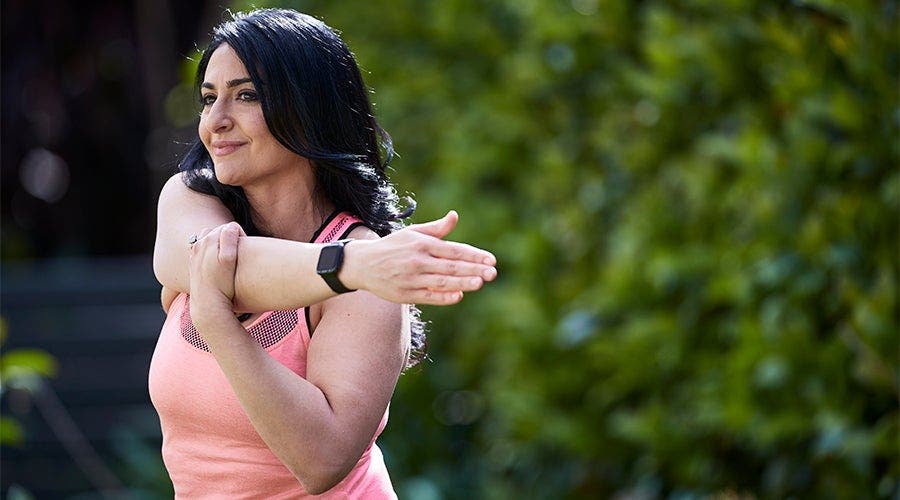

Programs like CrossFit and F45 helped popularise high-intensity interval training (HIIT), but their hardcore reputations also created the image that HIIT is only for the fittest people. And that’s not true. Interval training can be safe and beneficial for anyone—even beginners.
HIIT involves switching between periods of vigorous and easy intensity exercise. Since perceived effort is subjective—for example, what feels really hard to your friend may be just moderate to you—interval training is completely customisable. What’s more, you can turn nearly any activity (even walking and swimming) into a HIIT session.
So don’t be intimidated by HIIT! Discover how this type of training can help you exercise more efficiently, and give it a try with our beginner-friendly plan.
What is HIIT cardio?
HIIT is a form of exercise where you alternate between short periods of vigorous effort (77 to 93 per cent of your maximum heart rate, if you’re counting) and easier recovery periods (40 to 50 per cent of your maximum heart rate). You can turn any activity into a HIIT workout without a heart rate monitor: For example, if you walk as fast as you can for 30 seconds and then walk slowly for a minute, you’re performing HIIT. You can incorporate HIIT into your usual treadmill cardio session by sprinting or increasing the incline during the high-intensity segment, and slowing down or decreasing the incline during the rest period. In a pool or at a park, skip the timer and use laps instead: Try going at a high intensity for one lap, and then recover for two laps.
How does a HIIT workout plan work?
It’s easy to design a HIIT workout. First, decide what kind of activity or exercises to do, and then plan how long you’ll go hard and recover. “Be careful with your work-to-rest ratio,” says Kelvin Gary, a certified personal trainer.. “You need to recover enough in the rest interval to allow you to go just as hard in the subsequent rounds or sets.” Start with a 1 to 2 or 1 to 3 work-to-rest ratio, he says. For example, do an exercise at a high intensity for 30 seconds, recover for 60 or 90 seconds, and then move on to the next interval or exercise.
HIIT exercises for beginners
Looking for a beginner-friendly HIIT workout? Pick four exercises from the list below. “Try to target your upper body, lower body, and core,” Gary says. Do each of your four exercises for 30 seconds, taking a 60 to 90 second rest between each exercise to catch your breath. Aim to repeat each round of exercises three to five times.
1. High knees
This exercise challenges your entire body and is easy to modify for different levels.
How to do it:
- Stand with feet together and elbows bent at sides, palms facing inwards.
- Lift right knee as you bring left arm forward and push right arm behind you.
- Switch sides, lifting left knee in front of you as you bring right arm forward and push left arm back.
- Continue, moving at a quick pace.
To make it harder: Run in place, lifting your knees as high as you can.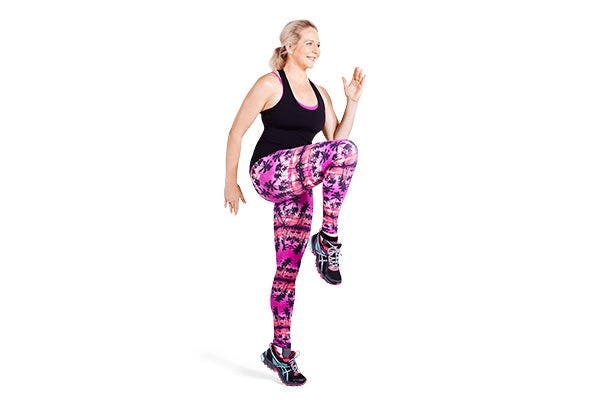
2. Star jumps
This P.E. class favourite gets your heart rate revving while strengthening your shoulders, arms, core, and legs.
How to do it:
- Stand with your feet together, arms at your sides.
- Jump as you separate feet wide apart and raise your arms overhead, clapping hands together.
- Jump, returning to the starting position.
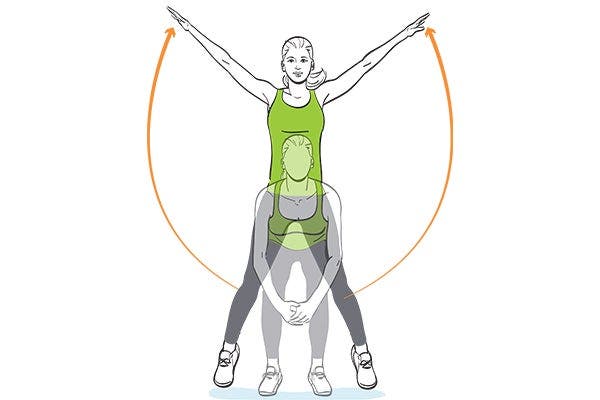
3. Push-up
While this exercise focuses on your shoulders and chest, your entire core works to stabilise you.
How to do it:
- Get on all fours with your hands on the floor, wrists aligned under shoulders.
- Extend your legs behind you, so your head, hips, and ankles form a line.
- Bend your elbows, lowering your chest toward the floor without touching.
- Push up, extending your arms to return to the starting position.
To make it easier: Place your knees on the floor.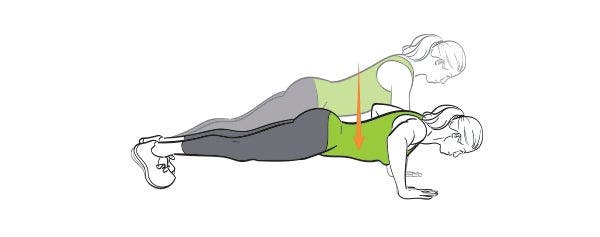
4. Toe tap
Strengthen your lower body with this alternating leg move.
How to do it:
- Stand facing a step with feet hip-width apart.
- Shift your weight to the left foot as you extend the right leg in front of you, tapping right toes on the step. Return the right leg to the starting position and repeat on the opposite side.
- Continue, alternating feet each time.
To make it harder: Add a hop as you switch feet and move at a quick pace.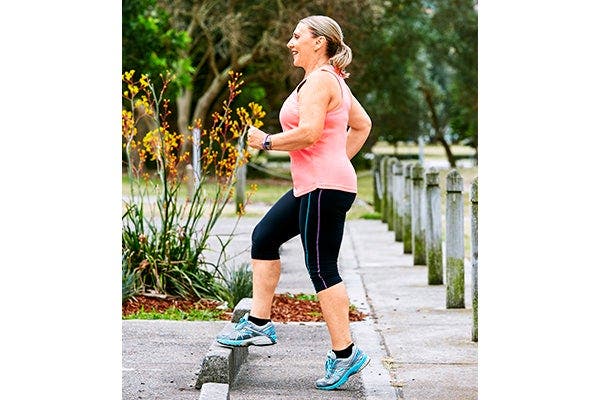
5. Broad jump (jump forwards)
Jumps like this one boost your muscles’ power and strength.
How to do it:
- Stand with feet hip-width apart and arms at your sides.
- Bend knees, reach arms behind you, and then jump forward as you reach arms overhead.
- Land lightly, and then walk back to your starting position and repeat.
To make it harder: Run or shuffle back to the starting position.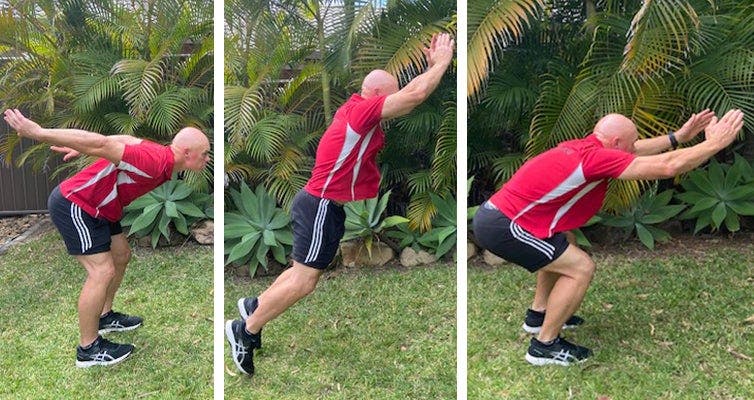
6. Step-up
You’ll feel this exercise in your thighs and glutes.
How to do it:
- Stand facing a step.
- Place your right foot on the step, then bring your left foot up beside it.
- Reverse the motion, stepping your right foot down followed by left, to return to the starting position.
- Repeat, this time starting with your left foot. Continue, alternating lead foot each time.
To make it harder: Use a higher object—such as a sturdy bench—instead of a step, or move at a faster pace.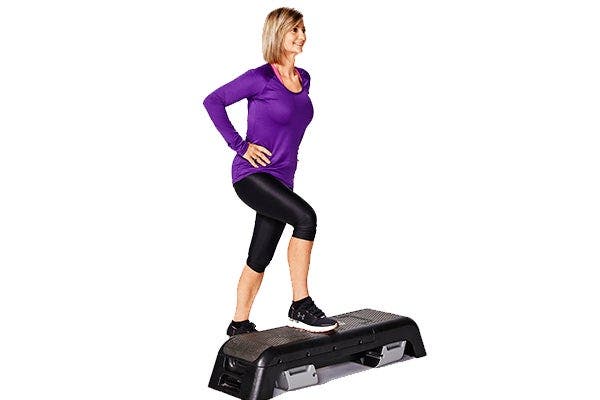
7. Bear crawl
This challenging exercise works all your major muscle groups.
How to do it:
- Stand with feet slightly wider than hips. Bend forward from your hips and place your palms on the floor, a stride’s length in front of your feet.
- Bend your knees slightly, and simultaneously step your right foot and left hand forward, followed by your opposite hand and foot.
- Continue moving forward until you run out of space, and then move backward. Repeat.
To make it harder: Try crawling from side to side instead of forward and back.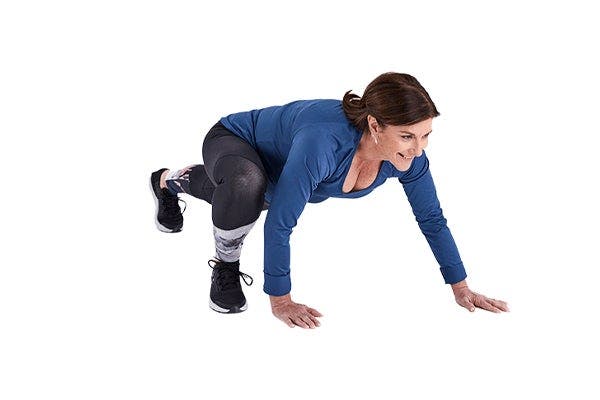
8. Straight punch
Punching strengthens your core, shoulders, arms, and back.
How to do it:
- Stand with left foot slightly in front of right and knees slightly bent.
- Bend your elbows and hold your hands in fists in front of your chin, palms facing each other.
- Forcefully extend your right arm, punching straight out in front of you. Immediately switch arms, returning your right arm to the starting position as you punch with your left arm.
- Continue, alternating arms. Switch feet (stand with opposite foot in front) on your next round.
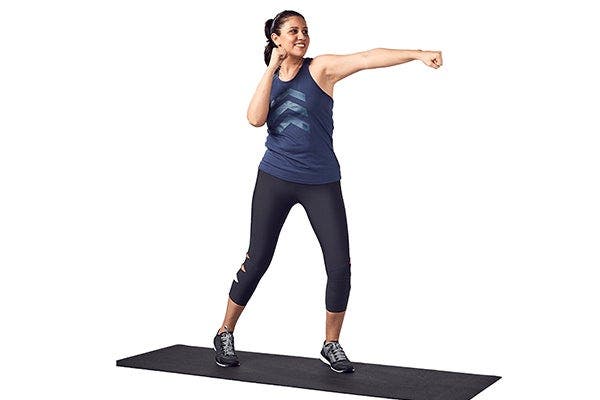
9. Squat
When it comes to strengthening your legs and glutes, it’s hard to beat the effectiveness of a squat.
How to do it:
- Stand with your feet slightly wider than your hips and arms at your sides.
- Raise your arms to shoulder height in front of you as you bend your knees and push your hips back until your thighs are almost parallel to the floor.
- Stand up to return to the starting position.
To make it harder: Jump as you rise up, extending your arms behind you.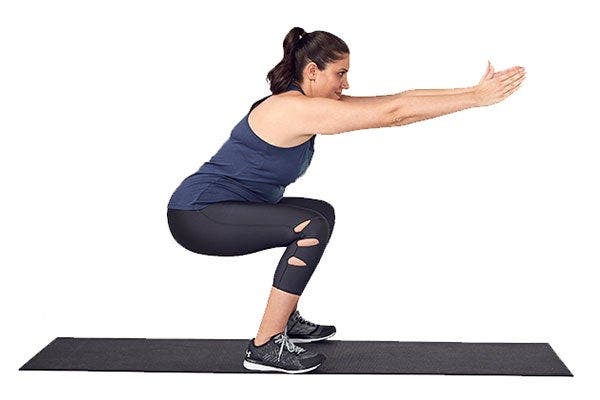
10. Side step
This lateral exercise targets your glutes and outer thighs while challenging your core.
How to do it:
- Stand with your feet together and knees slightly bent, hands on your hips.
- Keep your knees slightly bent as you take a big step to the right with your right foot. Step your left foot to the right so your feet are together again.
- Repeat, this time stepping to the left and starting with your left foot.
- Continue, stepping from side to side.
To make it harder: Hop from side to side instead of stepping.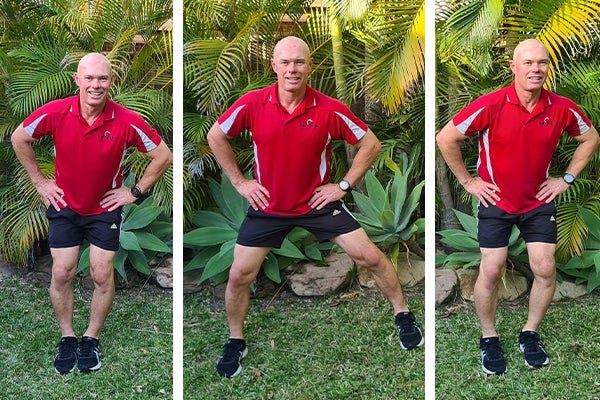
10 tips for getting started with HIIT
Here’s how to safely and effectively add HIIT to your exercise routine.
- Get your doctor’s okay: Check with your doctor before starting any new exercise program.
- Time yourself: You’ll need a clock with a second hand or your phone’s stopwatch. You could even try downloading a free interval timer app.
- Use a consistent work-to-rest ratio: Choose whatever ratio you want, but keep it the same for your entire workout. For example, if you do 30 seconds of work followed by 60 seconds of rest, you’re following a 1:2 ratio.
- Check your intensity: Ask yourself, “on a scale of 1 to 10, how hard am I working?” During a high-intensity interval, aim for at least a 7. (You should be breathing heavily and unable to say more than a few words.)
- Try not to sit down: Use your recovery intervals to catch your breath, not completely rest.
- Start off easy: If you feel like you can’t recover between circuits, decrease the intensity a bit by doing an easier exercise, moving more slowly, or decreasing the resistance if you’re using weight.
- Know when to take it up a notch: “As you get stronger, add more exercises or increase the time of your work intervals and shorten your rest,” says Gary.
- Mix it up: Regularly change workout variables such as the exercises, interval length, and number of moves. Your body eventually gets used to a challenge, which can halt your progress. It also helps to keep things interesting, so you don’t get bored doing the same routine every time.
- Listen to your body: Expect hard breathing, a rapid heart rate, and burning muscles when you push yourself. However, if you have joint and back pain, feel lightheaded, or can’t catch your breath during a rest period, ease up or stop and speak to your doctor if need be.
- Don’t do it every day: HIIT training is intense, so try it only once or twice per week, with at least 48 hours between workouts.
Benefits of HIIT workouts
HIIT produces physiological, metabolic, and physical changes in your body. A few more good reasons to give it a try:
- You’ll save time: When it comes to getting fitter, HIIT can cut your workout time in half. In a study published in the Journal of Sports Science and Medicine, people who did 14-minute workouts that included HIIT made similar fitness improvements as those who did half-hour sessions at a consistent effort.
- It increases your burn: Exercising at a higher intensity burns more calories than working at an easier effort. Plus, when you work out vigorously, your body needs more energy to return back to its resting state—this results in a slight increase in calorie burn after your workout, research shows.
- You’ll get a health boost: Interval training may lower your risk of cardiovascular disease, improve your cholesterol and insulin sensitivity, and reduce your blood pressure, according to the American College of Sports Medicine. Research also shows that HIIT may help improve blood glucose levels in people with type 2 diabetes, or those at risk of developing it.
HIIT workouts for weight loss
HIIT provides similar benefits as moderate intensity workouts for weight loss, but it may provide greater reductions in fat, according to a study published in the British Journal of Sports Medicine. Plus it’s more efficient, since every minute you spend exercising vigorously burns more calories than the same 60 seconds at a moderate intensity.
Ready? Set! HIIT!
More research still needs to be done on HIIT training, but there’s no denying that there are many health and timesaving benefits of this type of workout. You can tailor the intensity to your fitness level and choose the activity or exercises you do—and you don’t need to be an athlete or have access to a gym either. Anyone can do HIIT, anywhere—no gear required!
